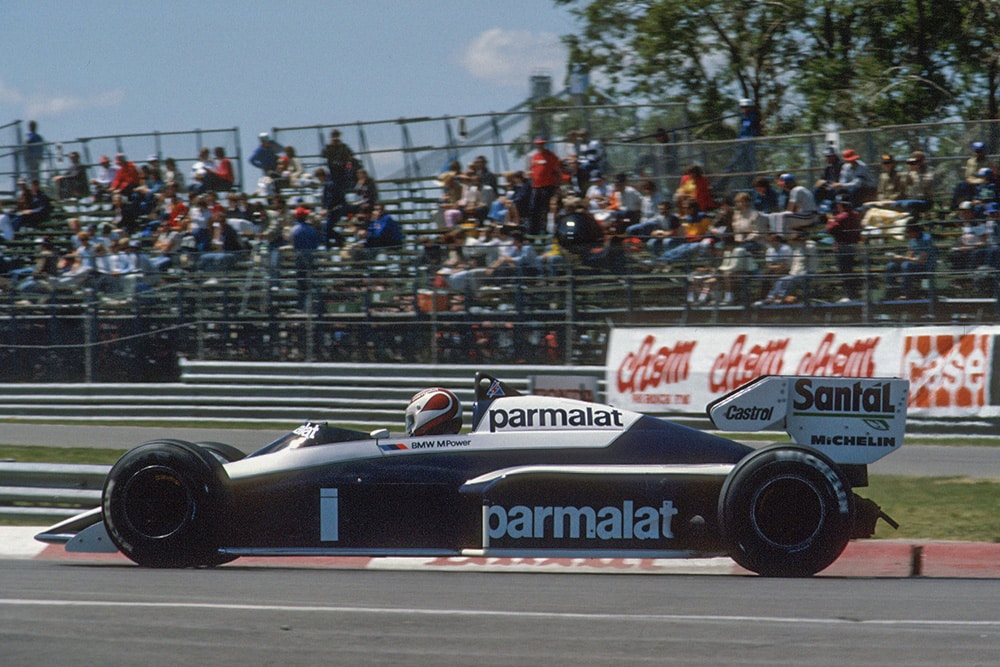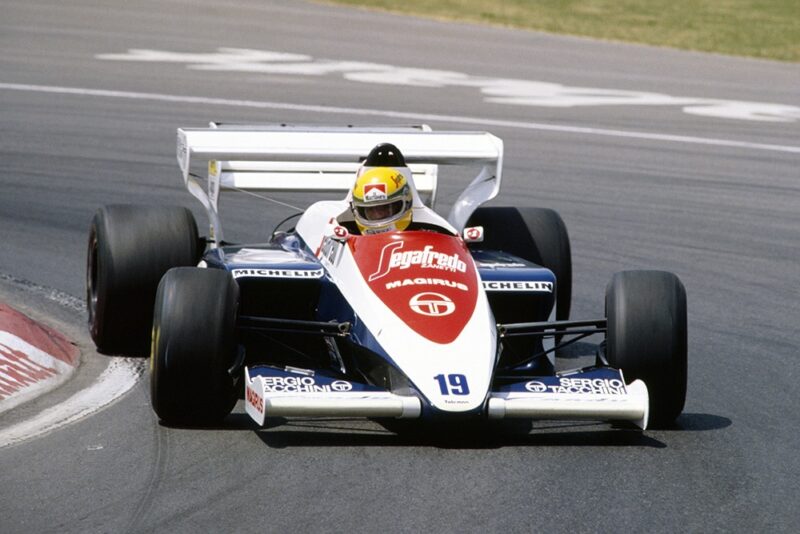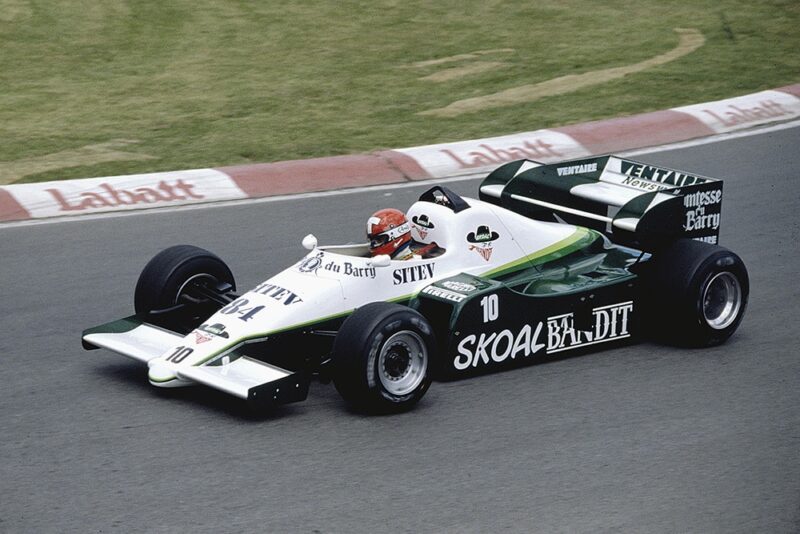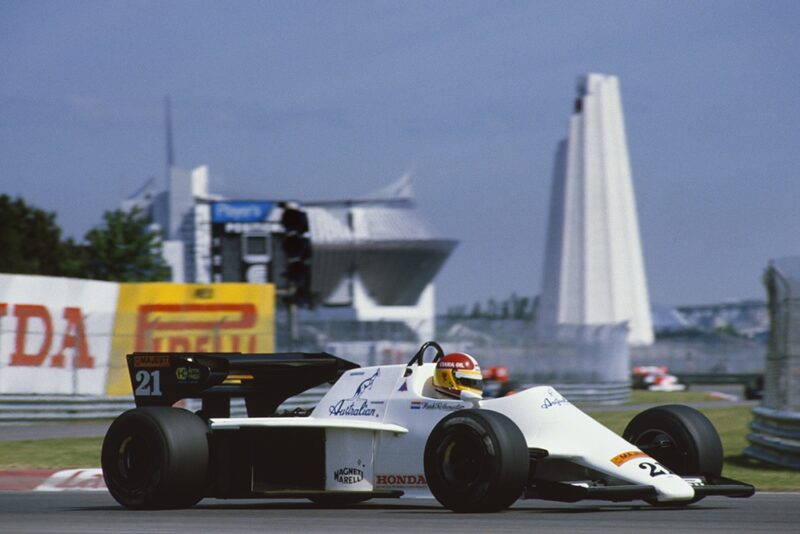1984 Canadian Grand Prix race report

Brabham's Nelson Piquet claimed his first win of the season
Motorsport Images
On two occasions now the Canadian Grand Prix at Montreal has underlined the fact that you can never ignore the Brabham team. Two years ago Nelson Piquet arrived from the previous weekend’s Detroit Grand Prix having failed to qualify for the American event — and went straight out to score the Brabham-BMW BT50’s maiden Grand Prix triumph. This year, after failing to finish in the first six races, Piquet again came bouncing back into prominence by leading this year’s Canadian event virtually from start to finish. It all goes to prove that the partnership between the twice World Champion Brazilian and Brabham designer Gordon Murray is one that can be turned upside down.
Piquet’s performance at Montreal was more typical of his 1983 Championship-winning season than the shambles we’ve witnessed of the Brabham organisation so far this year. He grabbed pole position convincingly with a lap in 1 min. 25.442 sec., just beating the McLaren MP4/2 of Alain Prost for premier position on the front row and it was clear that these two very serious contenders, neither of whom ever cause any surprise when they win a race, would probably fight the contest out to the finish.
In the event, Nelson Piquet triumphed quite comfortably. Although Prost was first away from the grid and led the field down to the hairpin at the far end of the circuit, Piquet drove past him coming back along the return straight with an ease that reminded us just how powerful BMW’s four-cylinder turbocharged engine is when it is running efficiently. It has been suggested this year that one of the reasons the McLaren cars have been able to run so quickly and, at the same time, look so unobtrusive and undramatic out on the circuits is because the Porsche-built V6 engines develop sufficient power to haul large rear aerofoils down the straights at competitive speed while still retaining enormously efficient cornering performance. Since the McLarens have been so reliable as well, there has been a tendency to regard them as the most powerful cars in the business. But perhaps Montreal taught us that the Brabham team’s mechanical misfortunes had allowed us to forget F1’s established pacemakers over the past six months. We really shouldn’t have been surprised at Nelson’s performance in Montreal, bearing in mind what we already know about him!

Ayrton Senna qualified 9th for Toleman, finishing 7th
Motorsport Images
Prost chased hard for the first half of the 70 laps race, but the Brabham-BMW always seemed well in control, particularly when it came to threading its way through slower cars. The Frenchman later complained that his engine refused to rev. willingly over 10,000 rpm for much of the race and on lap 44 he conceded second place to his team-mate Lauda. The Austrian had only qualified eighth after making, by his own admission, some mistakes in the detailed set-up of his chassis and in the opening stages of the Grand Prix he demonstrated a restraint that is only bred by true self-confidence. Knowing full well that the Montreal circuit, with its hairpins at either end, is hard on tyres and brakes, Lauda kept the pace of his race down in the early stages in order to conserve these components while the car was still heavy with a full load of fuel. After 20 laps or so he really began to pile on the pressure and disposed of Prost with no difficulty at all before settling down to try and catch Piquet. Lauda subsequently reported that his car had run perfectly “apart from a slight problem selecting fourth gear from time to time” and his only big drama came when Elio de Angelis went autocrossing across the apex of one of the hairpins, lurching back onto the track in an unruly manner that obliged the McLaren driver to put all four wheels “on the dirt” to avoid the wayward Lotus. At this point Lauda had only just overtaken his team-mate and Prost very nearly re-took second place in the ensuing scrum, but Lauda managed to keep his advantage and quickly regained his rhythm.
Although Piquet eased back quite noticably over the last few laps, allowing Lauda to close to just over two seconds adrift at the chequered flag, there was really no way in which he was going to be caught unless he made an untypical mistake. However, one should praise the disciplined fashion in which the McLaren drivers dealt with each other. By the time Lauda pulled up onto Prost’s tail there was no question that the Austrian was lapping much quicker than his partner. But there was no question of unruly tactics, no baulking, weaving or banging wheels. Although team rules permit them to compete with each other just as energetically as they do with their rivals, Lauda sliced ahead of his colleague without any delay or problems. Both men are confident, successful and highly intelligent exponents of the art of Grand Prix racing — qualities which reflect more than simply the ability to drive a racing car quickly round a track.
As an interesting contrast to the McLaren team’s behaviour, Elio de Angelis and Nigel Mansell put on a less disciplined performance in their Lotus 95Ts — although one should say that the Italian, on this occasion, was rather more to blame than the Englishman. De Angelis did well during qualifying and could be regarded as unlucky not to earn a position on the front row of the grid, being demoted to third in the helter-skelter of activity during the final hour. Mansell qualified seventh, similarly hampered by mechanical gremlins during the two days of practice, but once the race began the two men raced hard all the way. De Angelis found that his engine wouldn’t pull cleanly over 10,900 rpm while Mansell eventually caught his team-mate, but far from being helpful when it came to letting him overtake, Elio was downright obstructive and weaved round all over the track in a most indisciplined fashion.
At the end of the race de Angelis reasserted himself in fourth place, Mansell’s gearbox problems getting more serious and dropping him back to an eventual sixth. But it is quite clear that both drivers race for themselves as individuals, rather than displaying any overall responsibility for the team’s fortunes, whereas the McLaren drivers seem to sustain their individual ambition within that framework of overall team responsibility. I came away from Canada wondering why the Lotus drivers should be the way they are and concluded that this sort of frenzied competition stems from a need to assert themselves, bearing in mind that de Angelis has only ever won a single Grand Prix and Mansell none at all. Many people in Formula 1 these days believe that a Grand Prix driver should be utterly ruthless and that any element of fair play or generosity should be regarded as a weakness. That may be true to some extent, but Grand Prix racing is still a teamactivity (I won’t say sport) and there are many drivers in Formula One today who seem to have forgotten that simple truth.

Making his F1 comeback, Mike Thackwell retired after his RAM hit turbo issues
Motorsport Images
None the less, it should be recorded that only McLaren and Lotus managed to bring both their cars home in the top six, an achievement which makes a worthwhile contribution to the quest for Constructors’ Championship points. A few years ago Constructors’ points were only awarded for the best placed car from any particular team which finished, so if Ferrari finished in 1-2 formation it would only receive nine points for first place. Now we have a situation which is far more equitable, and as a result McLaren scored ten points towards the Constructors’ Championship at Montreal (six for second, four for third) while Brabham only scored nine points. Even though winning is the most important aspect of Grand Prix racing, it must be right to reward consistency and reliability, in addition to sheer competitiveness, and the McLaren team looks like reaping a correspondingly worthwhile harvest. At the time we went to press, immediately after the Canadian Grand Prix, that particular marque had 56½ points in the Constructors’ Championship: Ferrari was second on 25½ points!
After the race morning warm-up for the Canadian Grand Prix it looked as though Ferrari might be able to spring a surprise because Rene Arnoux and Michele Alboreto were first and second fastest in the half-hour warm-up session which frequently gives an accurate pointer to race form. For the first few laps it seemed as though those pointers were correct, Alboreto running third just ahead of his team-mate and “worrying” Prost’s second-place McLaren. Unfortunately the Italian was an early retirement with fuel pump drive failure and Arnoux, after starting on an unreasonably ambitious set of soft Goodyear tyres, was obliged to stop for harder rubber at the end of lap 14. Once he returned to the race he got his head down and worked his way back to fourth place before an exhaust pipe cracked and the consequent loss of boost pressure dropped him back to seventh. When Cheever’s well-driven Alfa Romeo 184T retired out of fuel, as was almost inevitable, Arnoux moved back to sixth place and he managed to squeeze his Ferrari ahead of Mansell’s Lotus on the very last lap to take fifth, the English driver unable to respond owing to gear selection troubles.
Outside the top six there were only a handful of unusually interesting talking points, including Ayrton Senna’s performance at the wheel of the Toleman TG184. Senna managed to qualify ninth in what was only his seventh Formula 1 race and ran on the tail of the leading bunch before braking and gear change problems slowed his pace somewhat and he eventually finished a physically exhausted seventh. This is the second time this season that the young Brazilian Formula graduate has finished the race with a visit to the medical centre, the first time being after taking sixth place at Kyalami. Like Nelson Piquet in the past, he needs to improve his physical fitness and stamina, but, that apart, he is beginning to demonstrate that the promise he displayed in the lesser single seater categories was not in any sense misleading. His progress will be followed with enormous interest for the balance of the season.

Spirit’s Huub Rothengatter was not classified after finishing 14 laps down
Motorsport Images
As far as the Williams-Honda organisation is concerned, the Canadian Grand Prix was an unmitigated disaster brightened only by Rosberg’s superb race performance in the FW09. To debate the Williams team’s technical problems in detail would be presumptuous in the extreme, not to say boring, but it is no exaggeration to describe the current chassis as a “lemon” and, more worryingly, there doesn’t seem very much that can be done in a short space of time. Rosberg qualified 15th, Laffite 17th, and the Finn drove an absolutely magnificent race to climb as high as sixth before his retirement with an apparent electrical fault after 33 laps. Williams’s entry into the world of turbocharged Formula One has by no means been crowned by success, but there is little doubt that chief designer Patrick Head is concentrating his efforts on reversing this unfortunate trend and, eventually, the green and white cars from Didcot will be seen back in more familiar surroundings at the front of the field. Until then, it will be difficult accurately to assess just how competitive is the V6 Honda turbocharged engine.
Talking of problems, the Renault Elf team was another experienced organisation to suffer a disappointing weekend, its problems compounded by the fact that Patrick Tambay was still not fit enough to take part following his Monaco leg injury. The Frenchman did three gentle laps in Friday’s unofficial practice session before calling it a day, leaving Derek Warwick to fight the French team’s battle alone. Despite all manner of handling problems and engine malfunctions, the Englishman qualified fourth and also rose to that position in the race before suspecting a puncture and stopping twice at his pit. It eventually transpired that part of the crucially important aerodynamic undertray beneath the rear of the Renault was coming away, badly upsetting the car’s handling, so the frustrated Warwick eventually retired 12 laps from the finish. Last year if you’d told him his Toleman was going to qualify and run fourth, Derek would have been doing cartwheels with sheer delight. This year with the Renault he was disappointed and annoyed, a reflection of just how quickly hopes and aspirations can change within the ever-competitive Formula One maelstrom.
A. H .
Results
Canadian Grand Prix–Formula One — 70 laps — Circuit Gilles Villeneuve Montreal • – 4.41 kilometres per lap — 308.700 kilometres — Hot
1st: Nelson Piquet ………………………..(Brabham BT53/5) ………………………….1 hr 46 min 23.748 sec — 174.085 kph
2nd: Niki Lauda …………………………….(McLaren MP4/2-1) ………………………..1hr 46 min 26.360 sec
3rd: Alain Prost …………………………….(McLaren MP4/2-2) ………………………..1 hr 47 min 51.780 sec
4th: Elio de Angelis ……………………….(Lotus 95T/4) …………………………………1 lap behind
5th: Rene Arnoux ………………………….(Ferrari 126C4/075) ……………………….2 laps behind
6th: Nigel Mansell …………………………(Lotus 95T/2)………………………………… 2 laps behind
7th: Ayrton Senna …………………………(Toleman TG184/2) ………………………..2 laps behind
8th: Manfred Winkelhock ………………(ATS-D7/1) …………………………………….2 laps behind
9th: Johnny Cecotto ………………………(Toleman TG184/3) ………………………..2 laps behind
10th: Martin Brundle ……………………..(Tyrrell 012/2)………………………………. 2 laps behind
11th: Philippe Alliot ……………………….(Ram 02/01)…………………………………. 5 laps behind
12th: Eddie Cheever ………………………(Alfa Romeo 184T/02) ……retired on lap 64 — out of petrol
13th: Marc Surer ……………………………(Arrows A6/4) ……………….retired on lap 60 — engine failure
14th: Derek Warwick ……………………..(Renault RE50/04) …………retired on lap 58 — undertray failure
15th: Huub Rothengatter ……………….(Spirit 101/2B) ………………still running — 14 laps behind
16th: Stefan Bellof …………………………(Tyrrell 012/4) ……………….retired on lap 53 — broken drive-shaft
17th: Andree de Ceseris ………………..(Ligier JS23/04) ……………..retired on lap 41 — engine failure
18th: Corrado Fabi …………………………(Brabham BT53/2) ……….retired on lap 40 — no boost pressure
19th: Thierry Boutsen …………………….(Arrows A7/2) ………………retired on lap 39 — engine failure
20th: Riccardo Patrese ……………………(Alfa Romeo 184T/01)…. retired on lap 38 — accident
21st: Keijo Rosberg …………………………(Williams FW09/5) ……….retired on lap 33 — electrical fault
22nd: Jacques Laffite ………………………(Williams FW09/3) ……….retired on lap 32 — turbo failure
23rd: Mike Thackwell ……………………..(RAM 02/02) ………………..retired on lap 30 — engine trouble
24th: Piercarlo Ghinzani ………………….(Osella FA/1F-3) ………….retired on lap 12 — gearbox trouble
25th: Michele Alboreto ……………………(Ferrari 126C4/076)……… retired on lap 11 –fuel pump drive
26th: Francois Hesnault ……………………(Ligier JS23/02) ………….retired on lap 8 — turbo failure
Fastest lap: Nelson Piquet ………………..(Brabham BT53/5) …………………………….on lap 55 in 1 min 28.763 sec — 178.858 kph
26 starters — 12 finishers
